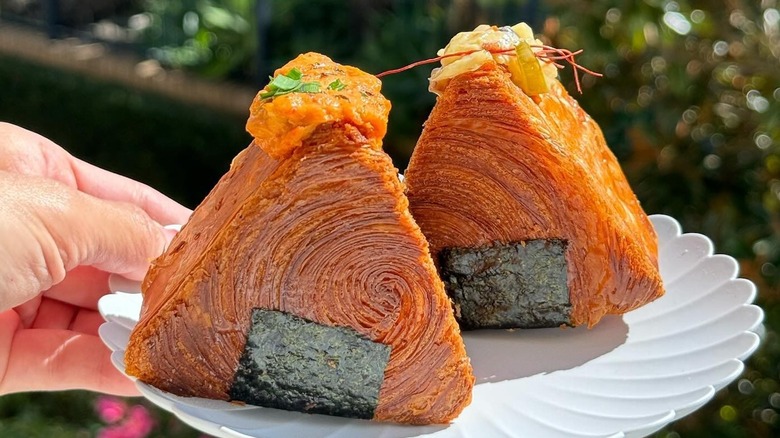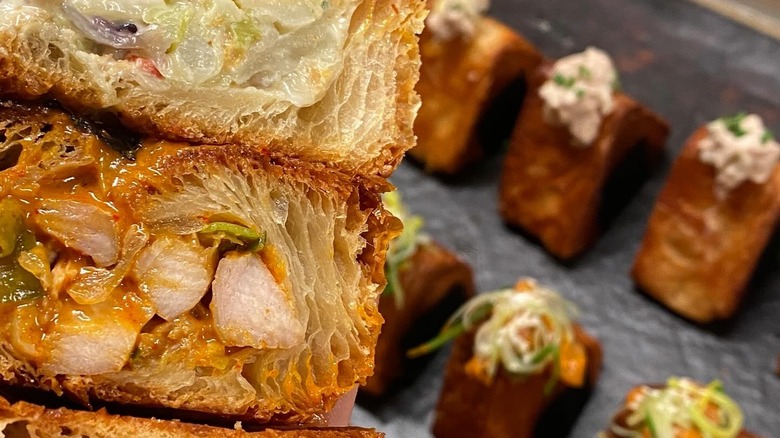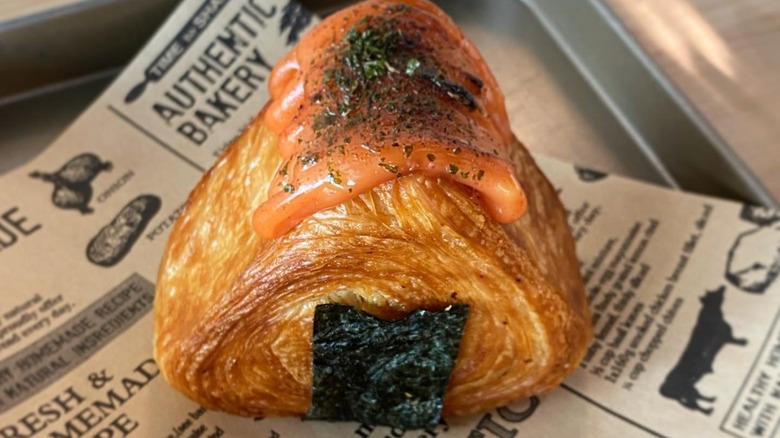Where You Can Find Cronigiri — The Latest Viral Croissant Trend
If you see a mile-long line forming outside a bakery, it's safe to assume there's an Instagrammable treat involved. Maybe it's a cronut, a croffle, or a cromboloni, but if you know where to look, it might be something even newer and more inventive — a cronigiri. Also known as an onigiri croissant, or an onioissant, this elusive pastry can be hard to find. Luckily, we've chased down some of the best places to try one for yourself.
If you're feeling apprehensive, like all of these riffs on the classic croissant are sacrilegious, let's take a step back. Pastry fusion isn't a new concept. Croissants are part of a larger family of viennoiserie, foods somewhere in the middle of bread or pastry that use a yeasted dough laminated with butter, and include pain au chocolat, pain aux raisins, chausson aux pommes (apple turnover), and bear claws — which are more pastry than donut. So you could say that making food mashups that include some variation of croissant as a prefix is less about adhering to tradition and more about name recognition.
Perhaps the most famous croissant concoction came in the form of the cronut, pioneered by Dominique Ansel at his New York bakery of the same name in 2013. This donut-croissant combo was dubbed one of TIME's top inventions that year. Then came the muffin-inspired cruffin, popularized in 2015, and more recently, the aptly-named crookie, invented by a pastry chef in Paris of all places.
What is cronigiri?
Although it may seem like an unlikely pairing, croissant and onigiri are a match made in food heaven. Croissants, with their crisp and delicate layers, provide a rich backdrop for a variety of ingredients, from savory grilled cheese sandwiches to sticky and sweet croissant s'mores. Onigiri, the beloved Japanese staple, usually consists of a rice ball with a savory filling and seaweed wrapper to create a comforting handheld meal or snack. In the case of an onigiri croissant, the rice is swapped for flaky croissant dough.
Although morphing onigiri into a croissant-based format may raise some eyebrows among purists who appreciate the wholesomeness of traditional onigiri, creating cronigiri is a labor of love that takes days. Bakers start by mixing yeast, flour, water, milk, sugar, salt, and butter to make a croissant dough. After it rests, the dough is rolled out with cold butter and folded many times, a process called lamination, before resting again. Then, it is shaped into a triangle-shape using a mold, then baked and filled. The fillings often draw from Asian culinary influences, but can vary and be either sweet or savory.
Where to try cronigiri for yourself
If you're convinced that you have to try an onigiri croissant, many bakeries around the world have hopped on the trend. To try what many hail as the original cronigiri, head to Le Levain in Singapore, but get there early. The bakery has a limit of 30 cronigiri per flavor each day, with options like lao gan ma with chili crisp and bacon, mentaiko cheese with cod roe and a creamy cheese, scallion sour cream, and even KitKats (which are a common savory pairing lately). Elsewhere in Asia, Seoul, South Korea-based Nudake offers cronigiri flavors kimchi bacon, basil lemon, and green onion.
Farther from cronigiri mecca, Tenacious Bakery in Sydney is serving up inventive flavors like taco wasabi and spicy chicken curry. In the United States, Cafe W Bakery & Desserts of Flushing, Queens is becoming an onigiri croissant hot spot, often selling out of their mayonnaise with roe and chive, bacon, and cream cheese. But, if you visit and miss your chance to snag a cronigiri, the bakery also sells a croissant ice cream cone, named (of course) a crone.


